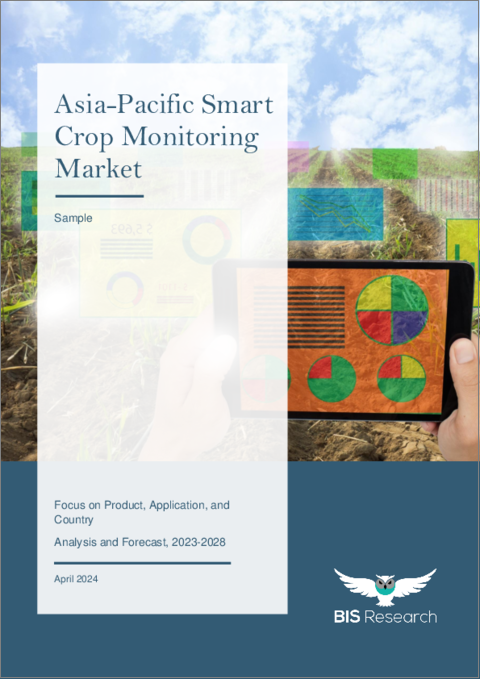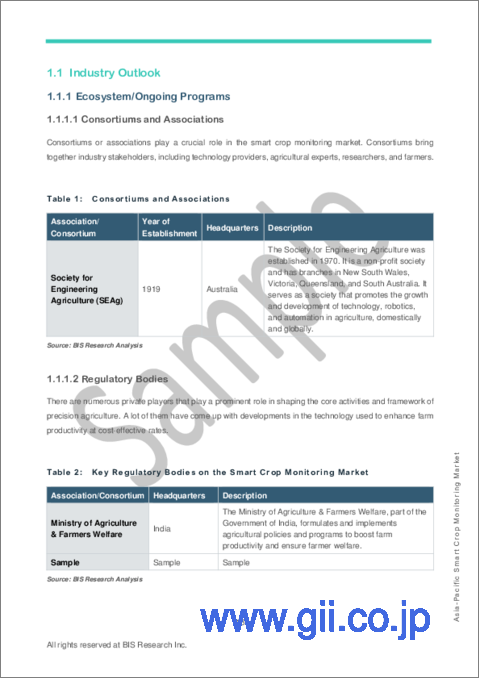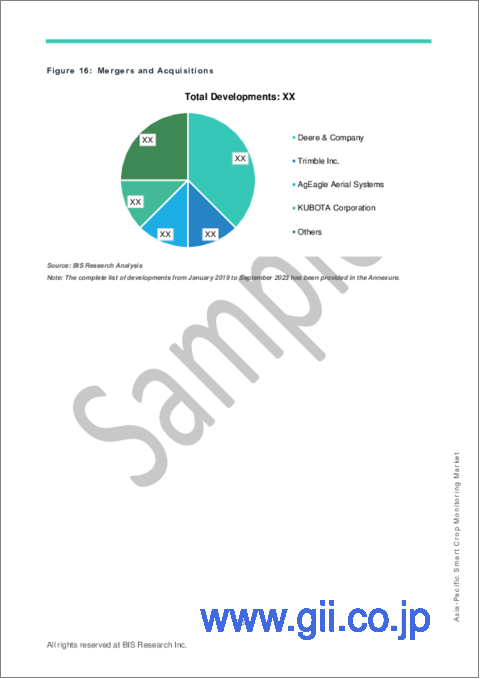|
|
市場調査レポート
商品コード
1473653
アジア太平洋のスマート作物モニタリング市場:製品別、用途別、国別:分析と予測(2023年~2028年)Asia-Pacific Smart Crop Monitoring Market: Focus on Product, Application, and Country - Analysis and Forecast, 2023-2028 |
||||||
カスタマイズ可能
|
|||||||
| アジア太平洋のスマート作物モニタリング市場:製品別、用途別、国別:分析と予測(2023年~2028年) |
|
出版日: 2024年05月07日
発行: BIS Research
ページ情報: 英文 60 Pages
納期: 1~5営業日
|
- 全表示
- 概要
- 図表
- 目次
アジア太平洋スマート作物モニタリングの市場規模(中国を除く)は、2023年に4億3,290万米ドルとなりました。
同市場は、予測期間の2023年~2028年に18.56%のCAGRで拡大し、2028年には10億1,440万米ドルに達すると予測されています。作物モニタリング市場の成長は、農業における作物収量と資源利用効率を最大化するニーズの高まりに起因すると予測されます。さらに、AI、機械学習、リモートセンシング技術の進歩は、作物モニタリングの成長をさらに加速させるとみられています。
| 主要市場統計 | |
|---|---|
| 予測期間 | 2023年~2028年 |
| 2023年評価 | 4億3,290万米ドル |
| 2028年予測 | 10億1,440万米ドル |
| CAGR | 18.56% |
アジア太平洋のスマート作物モニタリング市場は、同地域の進化する農業情勢と先端技術の採用増加により、著しい成長を遂げています。アジア太平洋地域は世界の農業生産高に大きく貢献しており、生産性の向上、資源利用の最適化、食料安全保障の確保が急務となっています。スマート作物モニタリングソリューションは、農家に作物の健康状態、土壌状態、環境要因に関するリアルタイムの洞察を提供し、データ主導の意思決定と精密農業の実践を可能にします。さらに、人口増加、消費者の嗜好の変化、気候変動などの要因が、アジア太平洋におけるスマート作物モニタリング技術の需要を促進しています。中国、インド、日本、オーストラリアなどの国々は、政府のイニシアチブ、技術の進歩、スマート農業の利点に対する意識の高まりに支えられて、これらのソリューションの採用の最前線にいます。アジア太平洋地域が農業慣行の近代化を続けているため、スマート作物モニタリング市場は大きな成長と革新の準備が整っています。
当レポートでは、アジア太平洋のスマート作物モニタリング市場について調査し、市場の概要とともに、製品別、用途別、国別の動向、および市場に参入する企業のプロファイルなどを提供しています。
目次
調査範囲
エグゼクティブサマリー
第1章 市場
- 業界展望
- ビジネスダイナミクス
第2章 地域
- 中国
- アジア太平洋
- アジア太平洋(国別)
第3章 市場-競合ベンチマーキングと企業プロファイル
- 競合ベンチマーキング
- 競合ポジションマトリックス
- 市場シェア分析
- 企業プロファイル
- KUBOTA Corporation
- DJI
第4章 調査手法
List of Figures
- Figure 1: Factors Affecting Crop Production
- Figure 2: Asia-Pacific Smart Monitoring Market, $Billion, 2022-2028
- Figure 3: Market Dynamics for Asia-Pacific Smart Crop Monitoring Market
- Figure 4: Asia-Pacific Smart Crop Monitoring Market (by Application), $Million, 2022-2028
- Figure 5: Asia-Pacific Smart Crop Monitoring Market (by Product), $Million, 2022-2028
- Figure 6: Smart Crop Monitoring Market (by Region), 2022
- Figure 7: Plant Nutrient Consumption in U.S., 1960-2015
- Figure 8: EU Farm and Farmland by Land Size Class, 2018
- Figure 9: Cyber Attack Incidents with $1Million+ Reported Losses, 2009-2019
- Figure 10: Advantages of AI and ML in Smart Crop Monitoring
- Figure 11: Advantages of MTaaS
- Figure 12: Share of Key Market Strategies and Developments, 2019-2023
- Figure 13: Product Developments and Innovations (by Company)
- Figure 14: Partnerships, Collaborations, Joint Ventures, and Alliances
- Figure 15: Business Expansions
- Figure 16: Mergers and Acquisitions
- Figure 17: Competitive Market: High and Low Matrix for Smart Crop Monitoring Market
- Figure 18: Market Share Analysis of Smart Crop Monitoring Companies, 2022
- Figure 19: KUBOTA Corporation: Product and Customer Portfolio Analysis
- Figure 20: DJI: Product and Customer Portfolio Analysis
- Figure 21: Data Triangulation
- Figure 22: Top-Down and Bottom-Up Approach
- Figure 23: Assumptions and Limitations
List of Tables
- Table 1: Consortiums and Associations
- Table 2: Key Regulatory Bodies on the Smart Crop Monitoring Market
- Table 3: Government Initiatives and Impacts
Introduction to Asia-Pacific Smart Crop Monitoring Market
The Asia-Pacific smart crop monitoring market (excluding China) was valued at $432.9 million in 2023, and it is expected to grow with a CAGR of 18.56% during the forecast period 2023-2028 to reach $1,014.4 million by 2028. The growth of the crop monitoring market is anticipated to stem from the rising need for maximizing crop yields and resource utilization efficiency in agriculture. Furthermore, advancements in AI, machine learning, and remote sensing technologies are poised to accelerate the growth of crop monitoring even further.
| KEY MARKET STATISTICS | |
|---|---|
| Forecast Period | 2023 - 2028 |
| 2023 Evaluation | $432.9 Million |
| 2028 Forecast | $1,014.4 Million |
| CAGR | 18.56% |
Market Introduction
The Asia-Pacific (APAC) smart crop monitoring market is witnessing significant growth attributed to the region's evolving agricultural landscape and the increasing adoption of advanced technologies. With the APAC region being a key contributor to global agricultural output, there's a growing imperative to enhance productivity, optimize resource use, and ensure food security. Smart crop monitoring solutions offer farmers real-time insights into crop health, soil conditions, and environmental factors, enabling them to make data-driven decisions and implement precision agriculture practices. Moreover, factors such as population growth, changing consumer preferences, and climate variability are driving the demand for smart crop monitoring technologies in APAC. Countries such as China, India, Japan, and Australia are at the forefront of adopting these solutions, supported by government initiatives, technological advancements, and a growing awareness of the benefits of smart agriculture. As the APAC region continues to modernize its farming practices, the smart crop monitoring market is poised for significant growth and innovation.
Market Segmentation:
Segmentation 1: by Application
- Disease and Pest Detection
- Nutrient Management
- Weed Management
- Crop Insurance
- Others
Segmentation 2: by Product
- Sensor Technology
- Drones
- Robots
- Handheld Devices
- Software and Mobile Applications
Segmentation 3: by Country
- Japan
- India
- Australia and New Zealand
- Rest-of-Asia-Pacific
How can this report add value to an organization?
Product/Innovation Strategy: In the realm of smart crop monitoring, technological advancements are transforming agricultural landscapes. Smart crop monitoring solutions utilize diverse technologies such as IoT sensors, drones, and data analytics. These tools offer precise insights into crop health, optimizing irrigation, pest management, and harvest times. Innovations such as satellite imaging and remote sensing provide a holistic view of fields, empowering farmers to make informed decisions. The market encompasses a range of solutions, from real-time monitoring platforms to AI-driven predictive analysis, enabling farmers to enhance productivity and reduce resource wastage significantly.
Growth/Marketing Strategy: The smart crop monitoring market has witnessed remarkable growth strategies by key players. Business expansions, collaborations, and partnerships have been pivotal. Companies are venturing into multiple markets, forging alliances, and engaging in research collaborations to enhance their technological prowess. Collaborative efforts between tech companies and agricultural experts are driving the development of cutting-edge monitoring tools. Additionally, strategic joint ventures are fostering the integration of diverse expertise, amplifying the market presence of these solutions. This collaborative approach is instrumental in developing comprehensive, user-friendly, and efficient smart crop monitoring systems.
Competitive Strategy: In the competitive landscape of smart crop monitoring, manufacturers are diversifying their product portfolios to cover various crops and farming practices. Market segments include soil analysis tools, disease detection systems, and climate analysis solutions. Competitive benchmarking illuminates the strengths of market players, emphasizing their unique offerings and regional strengths. Partnerships with research institutions and agricultural organizations are driving innovation.
Table of Contents
Scope of the Study
Executive Summary
1 Markets
- 1.1 Industry Outlook
- 1.1.1 Ecosystem/Ongoing Programs
- 1.1.1.1 Consortiums and Associations
- 1.1.1.2 Regulatory Bodies
- 1.1.1.3 Government Initiatives and Impacts
- 1.1.1 Ecosystem/Ongoing Programs
- 1.2 Business Dynamics
- 1.2.1 Business Drivers
- 1.2.1.1 Need for Input Optimization
- 1.2.1.2 Growth in Farmland Consolidation
- 1.2.2 Business Challenges
- 1.2.2.1 Cyber and Online Data Security
- 1.2.2.2 Lack of Connectivity and Technical Awareness
- 1.2.3 Business Opportunities
- 1.2.3.1 Focus on Sustainability
- 1.2.3.2 Increase in Number of Cooperative Farming
- 1.2.4 Ongoing Trends
- 1.2.4.1 Integration with AI and ML
- 1.2.4.2 Monitoring Technology-as-a-Service (MTaaS)
- 1.2.5 Market Strategies and Developments
- 1.2.1 Business Drivers
2 Region
- 2.1 China
- 2.2 Asia-Pacific
- 2.2.1 Asia Pacific (by Country)
- 2.2.1.1 Japan
- 2.2.1.2 Australia and New Zealand
- 2.2.1.3 India
- 2.2.1.4 Rest-of-APAC
- 2.2.1 Asia Pacific (by Country)
3 Markets - Competitive Benchmarking & Company Profiles
- 3.1 Competitive Benchmarking
- 3.1.1 Competitive Position Matrix
- 3.1.2 Market Share Analysis
- 3.2 Company Profiles
- 3.2.1 KUBOTA Corporation
- 3.2.1.1 Company Overview
- 3.2.1.1.1 Product and Customer Portfolio Analysis
- 3.2.1.1 Company Overview
- 3.2.2 DJI
- 3.2.2.1 Company Overview
- 3.2.2.1.1 Product and Customer Portfolio Analysis
- 3.2.2.1 Company Overview
- 3.2.1 KUBOTA Corporation
4 Research Methodology
- 4.1 Data Sources
- 4.1.1 Primary Data Sources
- 4.1.2 Secondary Data Sources
- 4.1.3 Data Triangulation
- 4.2 Market Estimation and Forecast





